Dragonflies are insects belonging to the order Odonata, widely distributed in aquatic ecosystems and renowned for their impressive flight capabilities. While commonly observed in natural settings, many interesting facts about dragonflies remain largely unknown to most people. These insects possess truly surprising features that you likely never imagined. For instance, did you know dragonflies are older than dinosaurs, don't sting or bite humans, and serve as indicators of healthy ecosystems?
In this article by thedailyECO, we'll explore the 10 most fascinating dragonfly facts that show us just how extraordinary these insects really are.
They are older than the dinosaurs
Dragonflies have existed for approximately 300 million years, meaning they were already flying when the first dinosaurs began to appear on Earth. During that era, the oxygen content in the atmosphere was much higher than it is today, allowing some insects to reach gigantic sizes.
Fossil dragonflies of the genus Meganeura, for example, had wingspans of up to 28 inches (70 cm). Although their descendants today don't reach that size, their body structure has changed very little, demonstrating how effective their body structure was from the beginning.
Fascinated by ancient creatures? Discover how dragonflies' giant ancestors relate to other colossal animals from Earth's history in our comprehensive guide to prehistoric giants.
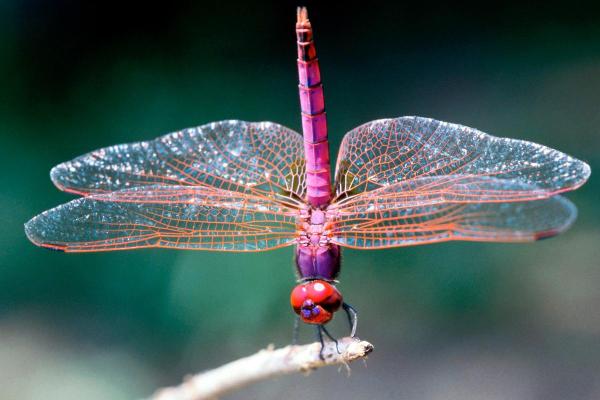
They are flight experts
The flight of dragonflies is one of the most sophisticated in the animal world. Unlike other insects, they can move each pair of wings independently, allowing them to perform aerial acrobatics with amazing precision. Dragonflies can accelerate rapidly, stop abruptly, turn in mid-air, and even fly upside down for brief moments.
How fast can a dragonfly fly?
Some species can reach speeds of up to 35 mph (56 km/h), which also makes them some of the fastest insects in the world. Their ability to hover in place allows them to hunt like natural drones. This skill not only helps them catch prey but also avoid predators such as birds, frogs, or spiders.
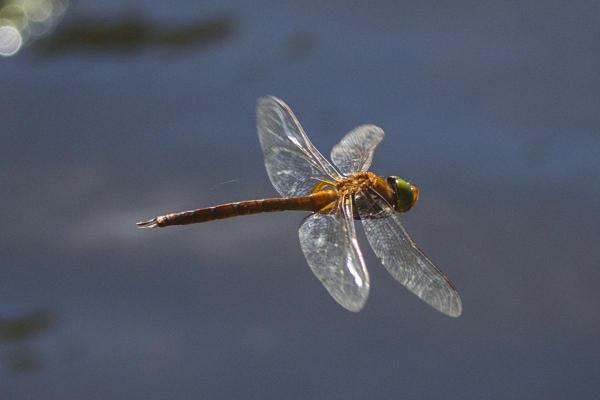
They are lethal hunters
Dragonflies are true predators of the air. Thanks to their speed, precision, and excellent vision, they can detect prey, calculate its trajectory, and catch it in mid-flight without fail. Most surprisingly, they don't hunt instinctively and erratically like many other insects. Various studies have shown that dragonflies adjust their flight based on the speed and direction of their target, anticipating its movements like a natural prediction system.
What do dragonflies eat?
Their diet consists mainly of mosquitoes, flies, bees, butterflies, and even other smaller dragonflies. Some dragonfly species can consume between 30 and 100 mosquitoes per day, which makes them valuable allies for humans, especially in areas with high densities of these pests.
They have nearly all-seeing eyes
Dragonflies' eyes are so large that they occupy almost their entire head, and for good reason: each eye can contain up to 30,000 ommatidia, the basic units of the compound eye. This allows them to see in almost all directions without moving their head. Furthermore, their vision isn't just panoramic, but also highly sensitive to movement and colors.
Studies have shown that dragonflies can see ultraviolet light and detect light polarization, something the human eye cannot do. This advantage allows them to distinguish other dragonflies, find water sources, and identify potential threats or prey from great distances.
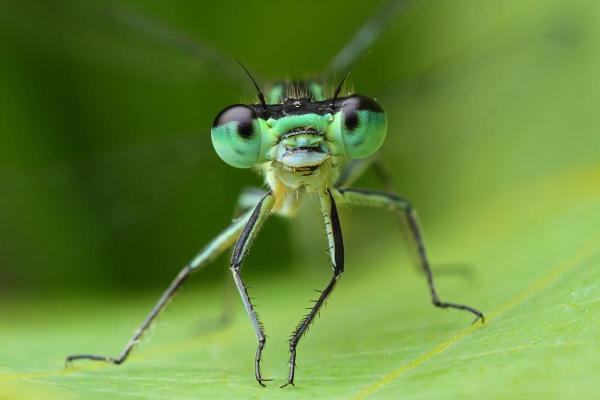
They are both aquatic and aerial
Although the most familiar image of a dragonfly is of a winged insect flying over a pond, they actually spend most of their lives as aquatic nymphs. During this phase, which can last from a few months to five years depending on the species and environmental conditions, they live hidden in mud or aquatic vegetation.
Dragonflies are active and voracious predators from the beginning, capable of extending a specialized appendage from their mouth to catch prey with impressive speed. Once they complete their development, they emerge from the water during the night or dawn, cling to a plant, and begin their metamorphosis. Their exoskeleton breaks open and the adult dragonfly emerges, ready to fly for the first time.
They are harmless to humans
Are dragonflies dangerous? Not at all. While dragonflies have powerful jaws to hunt and devour their prey, they do not use them against humans. They have no stinger or venom glands, so they don't sting, and if they land on a person's skin, they do so simply out of curiosity or to rest.
Even when handled, they rarely try to defend themselves, and if they do, their bite causes no pain or damage. This harmless reputation, however, contrasts with their fierce appearance, which has led to some ancient myths describing them as dangerous or symbolic animals, though science has debunked all of these myths. Learn more about how to handle dragonflies safely in our other article.
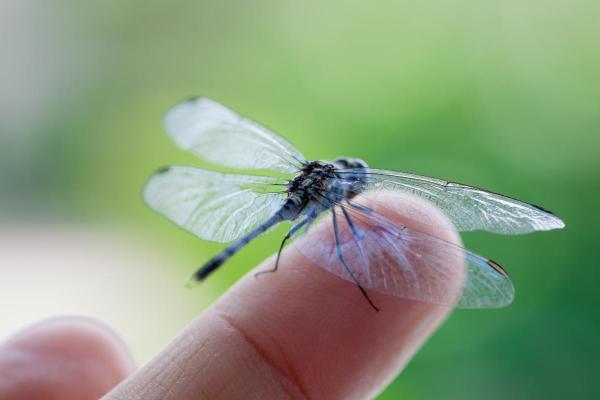
They are indicators of healthy ecosystems
Because they depend on clean aquatic environments to reproduce and develop, dragonflies are excellent bioindicators. The presence of multiple dragonfly species in an area usually indicates good water quality, biological diversity, and a balanced ecosystem. Conversely, if they disappear, it may signal pollution, drought, or environmental deterioration. Many biologists use them as reference points in ecological studies, especially in wetlands, where their disappearance is often one of the first visible signs of environmental degradation.
They are quite diverse
There are over 5,000 recorded dragonfly species worldwide, although it's estimated that there could be many more unidentified, especially in tropical regions. In some countries like Japan, dragonflies have significant cultural and symbolic value, representing courage, strength, and victory.
As for their appearance, their iridescent colors don't come from pigments but from the microscopic structure of their wings and exoskeleton, which reflects light in different ways. This phenomenon, called structural coloration, gives them a metallic shine that changes depending on the viewing angle, making them even more striking.
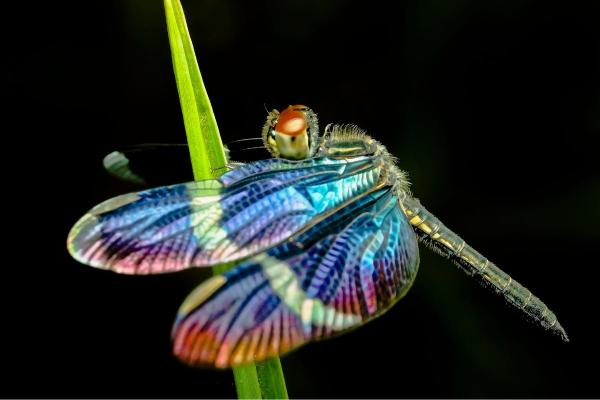
They have unique reproductive strategies
Reproduction in dragonflies is quite complex. Before mating, the male transfers his sperm from the end of his abdomen to a secondary structure closer to the thorax. He then grabs the female by the head or thorax using specialized claspers. To complete the process, she must curve her abdomen forward, forming the "mating wheel."
Additionally, some males use a kind of brush to clean traces of sperm from other males that may remain in the female, thus ensuring their paternity. Afterward, the female may lay eggs alone or accompanied by the male, who in some species stays with her to prevent other males from fertilizing her.
They are not the same as damselflies
Although often confused, dragonflies and damselflies (Zygoptera) belong to different suborders within the same order of insects, Odonata.
The differences between them are notable if observed closely. For example, when at rest, dragonflies keep their wings extended horizontally, while damselflies fold them back along their abdomen.
Furthermore, dragonflies have more robust bodies and large eyes that touch or nearly touch at the top of the head, while damselflies have thinner bodies and more separated eyes. Both fulfill similar ecological roles, but their behaviors, flights, and physical aspects reflect different adaptations.
Did you know that many people mistake similar winged insects for dragonflies? Learn the key differences between these commonly confused creatures in our other article.
If you want to read similar articles to Fun Facts About Dragonflies, we recommend you visit our Facts about animals category.
- Zielinski, S., & Kranking, C. (2024, December 9). 14 fun facts about dragonflies, from their lethal hunting prowess to incredible migratory feats . Smithsonian Magazine. Available at: https://www.smithsonianmag.com/science-nature/14-fun-facts-about-dragonflies-from-their-lethal-hunting-prowess-to-incredible-migratory-feats-96882693/
- McKenna, F., & Colver, E. (Eds.). (2019). Dragonfly information pack . British Dragonfly Society. Available at: https://british-dragonflies.org.uk/wp-content/uploads/2019/04/BDS-Dragonfly-Information-Pack.pdf